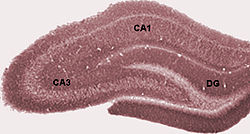This article needs additional citations for verification. (December 2008) |
| Perforant path | |
|---|---|
 Diagram of hippocampal regions. DG: Dentate gyrus. Perforant path not labeled, but would arise from the right. | |
| Details | |
| Identifiers | |
| Latin | tractus perforans |
| MeSH | D019580 |
| NeuroNames | 2686 |
| Anatomical terms of neuroanatomy | |
In the brain, the perforant path or perforant pathway provides a connectional route from the entorhinal cortex[1] to all fields of the hippocampal formation, including the dentate gyrus, all CA fields (including CA1),[2] and the subiculum.
Though it arises mainly from entorhinal layers II and III, the perforant path comprises a smaller component that originates in deep layers V and VI. There is a major dichotomy with respect to the laminar origin and related terminal distribution: neurons in layer II (and possibly layer VI) project to the dentate gyrus and CA3, whereas layer III (and possibly layer V) cells project to CA1 and the subiculum via the temporoammonic pathway.[1]
In addition to playing a role in spatial memory learning generally, the temporoammonic branch (TA-CA1) of the perforant path mediates spatial memory consolidation.[3] The temporoammonic pathway has also been implicated in stress-based animal models of depression.[4]
It may also play a role in temporal lobe seizures.[5]
- ^ a b Witter, Menno P.; Naber, Pieterke A.; Van Haeften, Theo; Machielsen, Willem C.M.; Rombouts, Serge A.R.B.; Barkhof, Frederik; Scheltens, Philip; Lopes Da Silva, Fernando H. (2000). "Cortico-hippocampal communication by way of parallel parahippocampal-subicular pathways". Hippocampus. 10 (4): 398–410. doi:10.1002/1098-1063(2000)10:4<398::AID-HIPO6>3.0.CO;2-K. PMID 10985279. S2CID 25432455.
- ^ Vago, David R.; Kesner, Raymond P. (2008). "Disruption of the direct perforant path input to the CA1 subregion of the dorsal hippocampus interferes with spatial working memory and novelty detection". Behavioural Brain Research. 189 (2): 273–83. doi:10.1016/j.bbr.2008.01.002. PMC 2421012. PMID 18313770.
- ^ Remondes, Miguel; Schuman, Erin M. (2004). "Role for a cortical input to hippocampal area CA1 in the consolidation of a long-term memory" (PDF). Nature. 431 (7009): 699–703. Bibcode:2004Natur.431..699R. doi:10.1038/nature02965. PMID 15470431. S2CID 4362619.
- ^ Kallarackal, A. J.; Kvarta, M. D.; Cammarata, E.; Jaberi, L.; Cai, X.; Bailey, A. M.; Thompson, S. M. (2013). "Chronic Stress Induces a Selective Decrease in AMPA Receptor-Mediated Synaptic Excitation at Hippocampal Temporoammonic-CA1 Synapses". Journal of Neuroscience. 33 (40): 15669–74. doi:10.1523/JNEUROSCI.2588-13.2013. PMC 3787493. PMID 24089474.
- ^ Scimemi, A.; Schorge, S; Kullmann, D. M.; Walker, M. C. (2005). "Epileptogenesis is Associated with Enhanced Glutamatergic Transmission in the Perforant Path". Journal of Neurophysiology. 95 (2): 1213–20. doi:10.1152/jn.00680.2005. PMID 16282203.
© MMXXIII Rich X Search. We shall prevail. All rights reserved. Rich X Search
